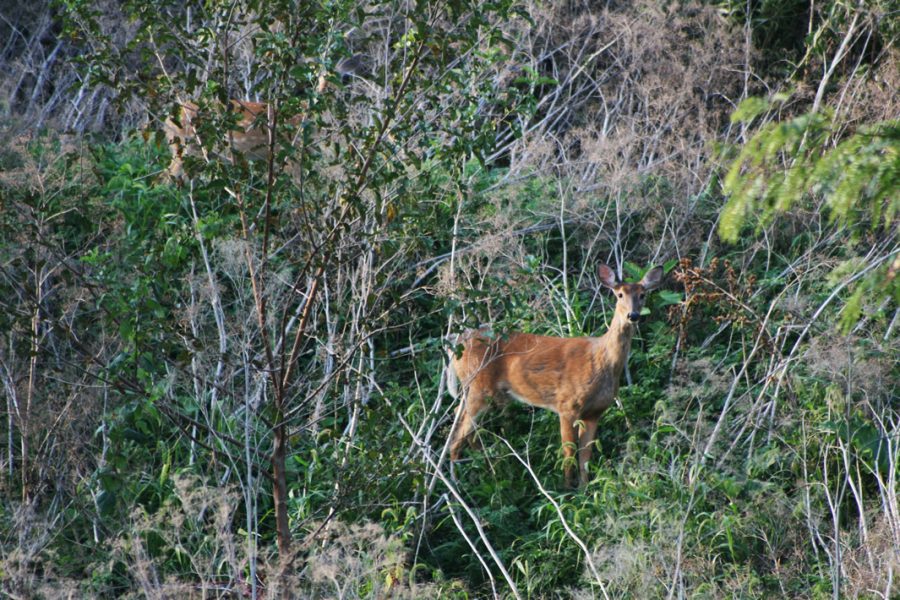Zombie Deer Disease
Can We Keep This Disease Out of Massachusetts?
USFWS, public domain, via Wikimedia
A deer in the midwest region of the United States with chronic wasting disease. Photo taken September 4, 2019
Mating season for deer is from September to November, and the gestation period (a fetus’ development period from the time of conception until birth) for deer is about seven and a half months. In May and June, the deer give birth. Later in the year, from September 28 to December 31, it is deer hunting season in Massachusetts.
These two factors are a concern for the Center for Disease Control (CDC) due to a large outbreak of Chronic Wasting Disease (CWD). The CDC is concerned because the transmission of the disease could be maternal, meaning offspring are infected in the womb and continue to be infected, and hunters may be hunting deer with CWD and processing the venison (deer meat).
Chronic Wasting Disease, also known as Zombie Deer Disease, is a contagious neurological disease that affects deer, elk and moose. According to a report by Ermias D. Belay entitled “Emerging Infectious Diseases, 10(6)2004,” published by the Center for Disease Control, it could take over a year before an infected animal develops symptoms, which are drastic weight loss (wasting), stumbling, lack of energy and other neurological symptoms.
CWD is fatal. “Most animals with the disease die within several months of illness onset, sometimes from aspiration pneumonia,” Belay stated. Currently there are no treatments. And the origin of CWD is unknown. “The only known natural hosts for CWD are deer (Odocoileus) and Rocky Mountain elk (Cervus elaphus nelsoni),” Belay’s report said. It may never be possible to definitively determine how or when CWD began.
CWD was first recognized as a syndrome in captive deer held in wildlife research facilities in Colorado in the late 1960s. It was not identified as a transmissible spongiform encephalopathies (TSE) until the 1970s. Computer modeling by the CDC suggests the disease may have been in free-ranging populations of deer for more than 40 years. Most are in populations in Colorado, Wyoming and Nebraska, according to Belay’s article. There are currently no reports of deer with CWD in Massachusetts, and information about the prohibition of deer into Massachusetts from other states is located at MassGov’s website.
Although there is concern that CWD could spread to humans because Creutzfeldt-Jakob disease (CJD), which occurs naturally in about one out of every one million people worldwide, and Variant Creutzfeldt-Jakob disease (v-CJD), which was associated with the large-scale outbreak of Bovine Spongiform Encephalopathy (BSE) in cattle herds in Great Britain, are also TSEs like CWD, but so far there is no proof in the scientific community that CWD could spread to humans.
Belay stated that “although the in vitro studies indicating inefficient conversion of human prion protein by CWD-associated prions raise the possibility of low-level transmission of CWD to humans, no human cases of prion disease with strong evidence of a link with CWD have been identified.”
CWD has been compared to CJD, also known as “Mad Cow” disease, but it is not known to affect humans. From 1997-1998, three cases of sporadic CJD occurred in the U.S. in young adults. These three people had consumed venison according to the CDC. This led to curiosity of possible transmission of CWD from deer, elk and moose to humans, which has not proved to be true.
The CDC has not found out how CWD is transmitted. The hypothesis is that the infectious agent of CWD may be passed in feces, urine or saliva. Transmission is thought to be lateral, from animal to animal. Although maternal transmission, from mother to fetus, may occur, it is not likely.
Although it does not appear that deer, elk or moose with CWD can spread it to humans, the CDC does not recommend hunting in areas with reports of infected animals or consuming the meat of infected animals. The most common areas to find animals infected with CWD are in the Mid-West United States.
According to the CDC, livestock such as cattle seem to be resistant to CWD by natural transmission. However, the CDC is performing experiments with injecting cattle with the disease to see if that could transmit the disease. Results are still pending.
There are no conclusive ways to diagnose CWD besides checking the brain, tonsils and lymph nodes after the animal’s death. As a precaution, hunters should use gloves when touching the meat and hide and not eat the meat or use the hides of infected animals.



Maximus Humberd • Jun 11, 2019 at 10:27 AM
I really enjoyed reading abut your article Michael! I feel like I learned a lot about this Zombie Deer Disease and I hope that you write more in the future!
David Ahearn • Jun 7, 2019 at 9:45 AM
very interesting
Jared Hermanson • Jun 7, 2019 at 8:59 AM
Great article Michael. It was very informative about where the disease was most populated. I also like how you explained how the effects of the disease on the deer.